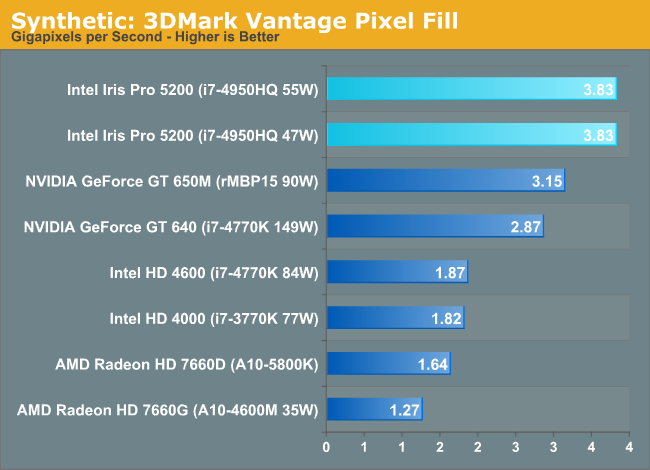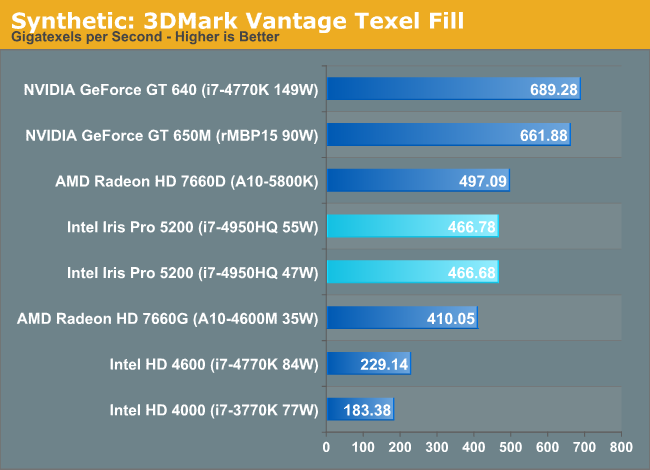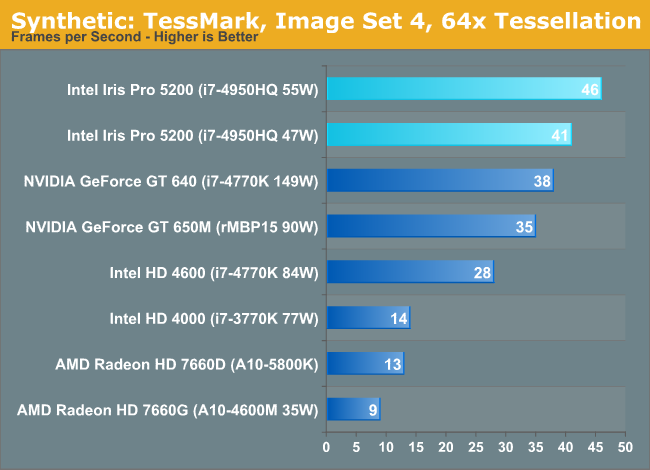Intel Iris Pro 5200 Graphics Review: Core i7-4950HQ Tested
by Anand Lal Shimpi on June 1, 2013 10:01 AM ESTSynthetics
Our synthetic benchmarks can sometimes tell us a lot about what an architecture is capable of. In this case, we do have some unanswered questions about why Intel falls short of the GT 650M in some cases but not in others. We'll turn to 3DMark Vantage first to stress ROP and texel rates.

Iris Pro doesn't appear to have a ROP problem, at least not in 3DMark Vantage. NVIDIA can output more pixels than Iris Pro though, so it's entirely possible that we're just not seeing any problems because we're looking at a synthetic test. Comparing the HD 4600 to the Iris Pro 5200 we see near perfect scaling in pixel throughput. Remember the ROP hardware is located in slice common, which is doubled when going from GT2 to GT3. Here we see a near doubling of pixel fillrate as a result.
Moving on, we have our 3DMark Vantage texture fillrate test, which does for texels and texture mapping units what the previous test does for ROPs.

Now this is quite interesting. NVIDIA has a 50% advantage in texturing performance, that's actually higher than what the raw numbers would indicate. It's entirely possible that this is part of what we're seeing manifest itself in some of the game benchmarks.
Finally we’ll take a quick look at tessellation performance with TessMark.

Iris Pro doesn't appear to have a geometry problem. Tessellation performance is very good.










177 Comments
View All Comments
kyuu - Saturday, June 1, 2013 - link
It's probably habit coming from eluding censoring.maba - Saturday, June 1, 2013 - link
To be fair, there is only one data point (GFXBenchmark 2.7 T-Rex HD - 4X MSAA) where the 47W cTDP configuration is more than 40% slower than the tested GT 650M (rMBP15 90W).Actually we have the following [min, max, avg, median] for 47W (55W):
games: 61%, 106%, 78%, 75% (62%, 112%, 82%, 76%)
synth.: 55%, 122%, 95%, 94% (59%, 131%, 102%, 100%)
compute: 85%, 514%, 205%, 153% (86%, 522%, 210%, 159%)
overall: 55%, 514%, 101%, 85% (59%, 522%, 106%, 92%)
So typically around 75% for games with a considerably lower TDP - not that bad.
I do not know whether Intel claimed equal or better performance given a specific TDP or not. With the given 47W (55W) compared to a 650M it would indeed be a false claim.
But my point is, that with at least ~60% performance and typically ~75% it is admittedly much closer than you stated.
whyso - Saturday, June 1, 2013 - link
Note your average 650m is clocked lower than the 650m reviewed here.lmcd - Saturday, June 1, 2013 - link
If I recall correctly, the rMBP 650m was clocked as high as or slightly higher than the 660m (which was really confusing at the time).JarredWalton - Sunday, June 2, 2013 - link
Correct. GT 650M by default is usually 835MHz + Boost, with 4GHz RAM. The GTX 660M is 875MHz + Boost with 4GHz RAM. So the rMBP15 is a best-case for GT 650M. However, it's not usually a ton faster than the regular GT 650M -- benchmarks for the UX51VZ are available here:http://www.anandtech.com/bench/Product/814
tipoo - Sunday, June 2, 2013 - link
I think any extra power just went to the rMBP scaling operations.DickGumshoe - Sunday, June 2, 2013 - link
Do you know if the scaling algorithms are handled by the CPU or the GPU on the rMBP?The big thing I am wondering is that if Apple releases a higher-end model with the MQ CPU's, would the HD 4600 be enough to eliminate the UI lag currently present on the rMBP's HD 4000?
If it's done on the GPU, then having the HQ CPU's might actually get *better* UI performance than the MQ CPU's for the rMPB.
lmcd - Sunday, June 2, 2013 - link
No, because these benchmarks would change the default resolution, which as I understand is something the panel would compensate for?Wait, aren't these typically done while the laptop screen is off and an external display is used?
whyso - Sunday, June 2, 2013 - link
You got this wrong. 650m is 735/1000 + boost to 850/1000. 660m is 835/1250 boost to 950/1250.jasonelmore - Sunday, June 2, 2013 - link
worst mistake intel made was that demo with DIRT when it was side by side with a 650m laptop. That set people's expectations. and it falls short in the reviews and people are dogging it. If they would have just kept quite people would be praising them up and down right now.